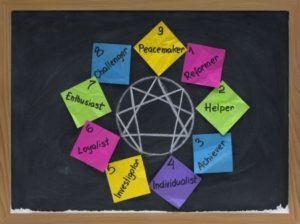 Are you looking for a place to start with this very powerful transformational tool? In my previous article, Understanding Yourself Using the Power of the Enneagram, I shared an overview of the 9 Enneagram types and how they can provide you with deep insights into your behavior and reactivity and a path for transformation.
Are you looking for a place to start with this very powerful transformational tool? In my previous article, Understanding Yourself Using the Power of the Enneagram, I shared an overview of the 9 Enneagram types and how they can provide you with deep insights into your behavior and reactivity and a path for transformation.
One way to start your exploration of the Enneagram is to look at the three centers: The Body or Instinctive center, the Heart center and the Head center. Each of these centers has three Enneagram types and a predominant theme.
The Body or Instinctive Center
In the instinctive center the three types are predominantly focused on creating a sense of autonomy and respect. This shows up differently in each of the three types in this center.
For example, the Type 8, the Challenger, the autonomy has a flavor of “don’t mess with me”. It’s important for this type to feel a sense of control and as result they can be seen as controlling and challenging. If they allow themselves to feel more vulnerable and open their hearts this brings on the highest aspect of the Type 2, their point of growth, and they begin to lead from a place of strength and heart.
For the Type 9, the Peacemaker, the autonomy is related to an unconscious desire to maintain all sense of connection. The way this shows up in the personality of these individuals is their tendency to be very accommodating while suppressing their own wants and desires. They tend to be complacent. As they become more grounded in their own desires they bring on the highest aspect of Type 3, their point of growth; courage, authenticity and inspiration. They begin to speak their wants and desires and pursue them without fear of losing the connection to the other or to the world.
The Type 1, the Perfectionist, are very principled, rational and disciplined commanding respect. Underlying this personality pattern is an unconscious belief that somehow, they’re not good. They create a life in which they’re seen as perfect or good. This can be challenging for those around them because nothing is ever quite good enough. As they become more aware of these patterns and more present to their reactions they see that there’s more to life than being right. They bring on the higher aspects of Type 7, the Enthusiast, which brings an appreciation for joy and freedom.
The Heart Center
In the Heart center the predominant focus is how to be seen. Individuals in this center unconsciously are focused on the image that they project into the world. For the Type 2, the Helper, there’s a deep unconscious desire to feel loved and lovable which drives the behavior of the type. These individuals tend to be very sweet, loving, nurturing, and kind. As their personality begins to lessen its hold, with consciousness and presence, they’re able to bring on the higher aspect of the Type 4, their point of growth, which brings an appreciation of beauty and creative expression.
For the Type 3, Achiever, they must be seen as successful and competent. Underlying the personality’s drive for success is an unconscious belief that they have no value therefore they must have their value reflected back to them from the outside. They are typically very driven and successful, often a shining star. As they become more aware of these patterns and are able to let them go they’re able to move to their point of growth which is the Type 6. At their best Type 6s are tremendous consensus builders and contribute significantly to the community without having to be the shining star.
The Type 4, the Individualist, must be seen as being special and unique due to an underlying sense of an inherent disconnect from a sense of identity. They unconsciously create an identity of being special or unique so that they can feel a sense of individuality. Again, this is unconscious as with all types. As that personality pattern loosens its hold when the individual becomes more conscious and aware of what’s happening with them, they move towards a higher aspect of Type 1 and have a sense of purpose and provide service to the world.
The Head Center
The Enneagram types of the head center also called the thinking center, all seek support and guidance as their predominant motivation. Underlying this motivation is anxiety and fear. It shows up differently for the three different types in the center. For the Type 5, Investigator, the fear is related more to a sense of feeling incapable of being in the world. As a result, this type holds back from fully engaging in the world and in their relationships. As they become more aware of this fear and are able to let it go they step into the world more fully and bring on higher aspects of the Type 8, their point of growth. They become more confident of their many inherent gifts and their inherent strength.
For the Type 6, the Loyalist, anxiety results from not feeling supported or guided. As a result, the personality tries to create the support by having everything figured out and planning for every worst-case scenario. As the Type 6 is able to trust that they are guided and supported they become less fearful and bring on the higher aspects of the Type 9, their point of growth, as they become more grounded in their being.
The Type 7, the Enthusiast, has an unconscious fear of losing a sense of joy and freedom. They craft a life around freedom from pain and suffering. This may look like they are the life of the party to others, however, they’re actually dealing with anxiety of not wanting to live with discomfort. As they become less attached to their personality they move towards the higher aspect of Type 5 which brings clarity and quiet to their mind.
Reflect on this and determine which of these centers resonates with you the most. Which of the three Enneagram centers feels like home to you? Use that as your starting point in navigating the Enneagram and landing on your Enneagram type.



